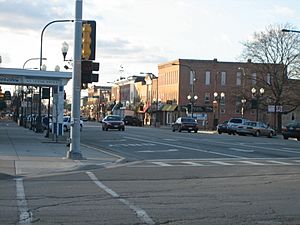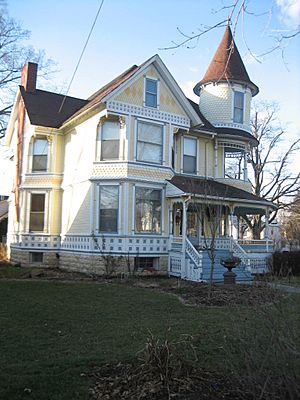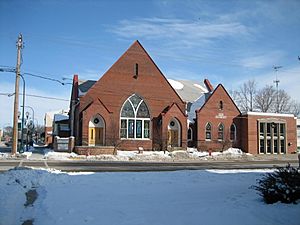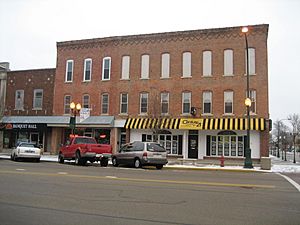Sycamore Historic District facts for kids
Quick facts for kids |
|
|
Sycamore Historic District
|
|

Streetside in the district
|
|
| Location | Irregular pattern along Main and Somonauk Sts., Sycamore, Illinois |
|---|---|
| Area | 99 acres (40 ha) |
| Architect | Multiple |
| Architectural style | Classical Revival, Greek Revival, Gothic Revival, Italianate, Medieval Revival, Queen Anne |
| NRHP reference No. | 78003104 |
| Added to NRHP | May 2, 1978 |
The Sycamore Historic District is a special area in Sycamore, Illinois, that covers about 99 acres. It's like a treasure map of old buildings and homes, right in the heart of downtown Sycamore. This district is famous for its beautiful Victorian houses and important places.
Some of the most well-known buildings here include the DeKalb County Courthouse and the Sycamore Public Library. Because of its historical importance, the district was added to the National Register of Historic Places on May 2, 1978.
There are more than 200 properties within this historic area. A large number of them, 187 to be exact, are considered "contributing properties." This means they are important parts of the district's history and character. About 75% of all the buildings here fit the idea of a historic district. You can find grand Queen Anne mansions and many houses from the mid-to-late 1800s.
Contents
Why is the Sycamore Historic District Important?
The Sycamore Historic District is special because it shows how a small American town grew over time. Many of its buildings have survived for over a century. They help us imagine what life was like long ago. The district's mix of homes, shops, and government buildings creates a peaceful and charming feel. It's often seen as a perfect example of an ideal small town.
How the District Was Created
Finding Historic Places in Illinois
In 1966, a law called the National Historic Preservation Act was passed. This law helped create the National Register of Historic Places. It also allowed each state to set up groups to find and protect historic sites. Illinois started its own program in the early 1970s. The Illinois Department of Conservation sent people out to look for places that could be added to the National Register.
Sycamore's Historic Discovery
In 1973, a surveyor visited Sycamore. They found many beautiful buildings from the late 1800s and early 1900s. The surveyor thought Sycamore would be a great place for a historic district. The mayor of Sycamore then asked local citizens to form a committee. This group helped the state with the work needed to get the district listed. Most of the historic district still looks much like it did when it was first organized in 1978.
Exploring the District's Boundaries
The Sycamore Historic District has an interesting shape. It stretches along Somonauk Street on the west and Main Street on the east. These are two main north-south roads. On the north side, it reaches Page Street. It also goes all the way to the end of South Main Street.
The district also includes parts of State Street (Illinois Route 64) to the west. Sections of Locust, Maple, and California Streets are also inside the district. Other east-west streets like Elm, High, Ottawa, Waterman, and Lincoln have parts included too.
Why the Boundaries Are Unique
A person named Robert Wagner drew the district's boundaries. He worked for the Illinois Department of Conservation. He decided where the district would be based on what looked "visually intact." This means he included areas that still looked historic. Because of this, the district's shape is a bit unusual. Sometimes, one side of a street is in the district, but the other side isn't. For some buildings, like the library or the U.S. Post Office, a special line was drawn just to make sure they were included.
Architectural Styles You Can See
The Sycamore Historic District is like an outdoor museum of different building styles.
Early Styles
You can find Greek Revival buildings from the 1830s. These are some of the oldest buildings still standing in the district.
Post-Civil War Styles
After the American Civil War, new styles became popular. You'll see buildings in the Italianate, Gothic Revival, and Queen Anne styles. These are found all over the neighborhood.
Grand Public Buildings
Government and commercial buildings often show off Classical Revival architecture. This style looks grand and important. Great examples include the beautiful DeKalb County Courthouse, the Sycamore Public Library, and the U.S. Post Office. The old Daniel Pierce Block, now the Sycamore Center, also has this style.
Out of 226 properties, 40 are considered "strongly contributing" to the district's look. Twenty-one of these are among the most important buildings. Most of the other buildings were built between 1860 and 1900.
Notable Buildings in the District
The Sycamore Historic District has a mix of homes, shops, government buildings, and churches. Many Victorian homes along Main Street are part of the district. In downtown Sycamore, many commercial buildings are included too. Each important building often has a plaque nearby to tell you about its history.
Churches in the District
Today, there are five church buildings in the Sycamore Historic District. When the district was first nominated, there were seven. One building, the Arthur Stark House, was actually a home first but was used as a church. Sadly, two churches have been lost since the listing. The Evangelical Church of St. John burned down in 2004. The United Methodist Church was replaced by a modern office building. The churches still standing are the Old Congregational Church, First Baptist Church, St. Peter's Church, the Universalist Church/Stark House, and St. Mary's Roman Catholic Church.
Downtown Commercial Buildings

Most of the commercial buildings in the district are in downtown Sycamore. You'll find many of these important shops and businesses along Illinois Route 64. Some buildings are known as "blocks," like the Waterman Block. These "blocks" can be made up of several connected buildings.
DeKalb County Courthouse
The DeKalb County Courthouse is often called the "gem" of the Sycamore Historic District. It sits in the middle of a town square, facing Illinois Route 64. It's directly across Main Street from the Sycamore Public Library. This courthouse is a stunning example of Classical Revival architecture. The building you see today was built in 1905. It was the third courthouse to serve DeKalb County.
Frederick Townsend Garage
The Frederick Townsend Garage is a unique stone building on Main Street. It was built in 1906 as a garage for Frederick B. Townsend's estate. His beautiful Queen Anne style home overlooks the garage. Today, this distinctive building is home to a restaurant. Even though it has changed from a private garage to a gas station and now a restaurant, its historic look remains.
George's Block
The George's Block building has changed a lot since it was built in 1857. But it's still one of the most eye-catching buildings in the district. It was first called the James Block, after its owner Daniel P. James. Many buildings from that time were called "blocks." They usually had multiple stories and housed several businesses. They could have shops, offices, or even lecture halls. Famous people like Horace Greeley spoke there in its first year.
Historic Homes in Sycamore
The houses in the Sycamore Historic District show many different architectural styles. They were built from the 1830s to the early 1900s. Many of these homes are linked to important early residents of Sycamore. These were often business leaders or politicians. Some famous homes include the Charles O. Boynton House and the Frederick B. Townsend House.
Sycamore Public Library
The Sycamore Public Library is the only building on the east side of Main Street, between State and Page Streets, that is part of the historic district. The library is still used today. It was built in 1905 with money donated by different people, including Andrew Carnegie. The building was partly designed by architect Paul O. Moratz.
Images for kids
-
A view of downtown Sycamore, toward the George's Block and the Citizens National Bank Building.














